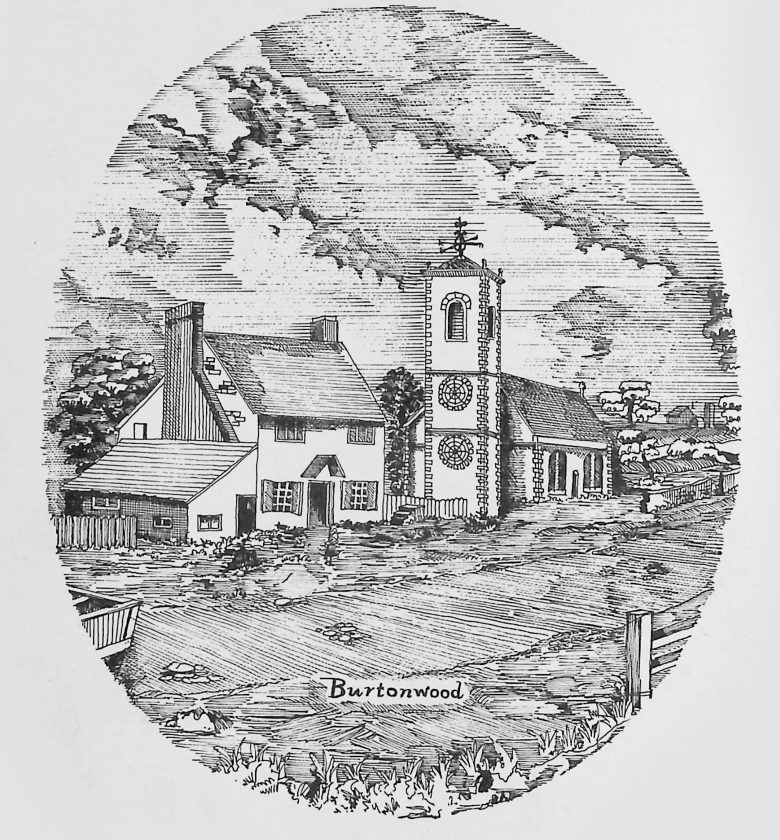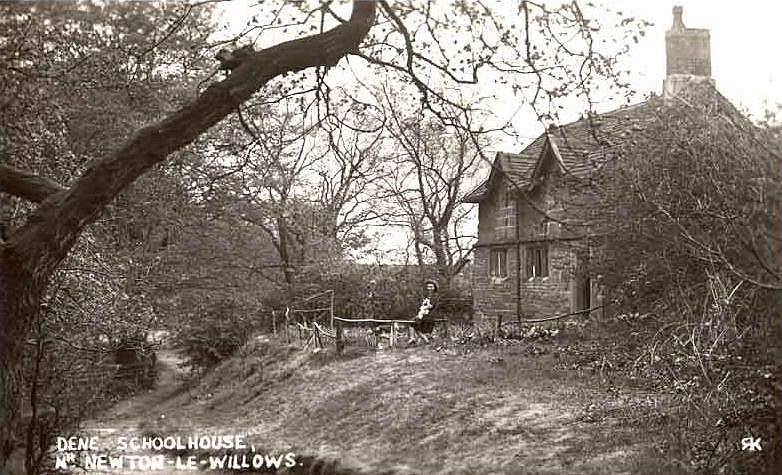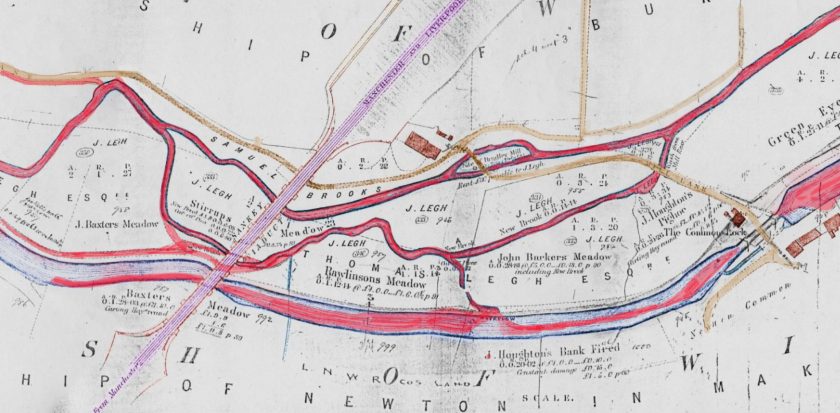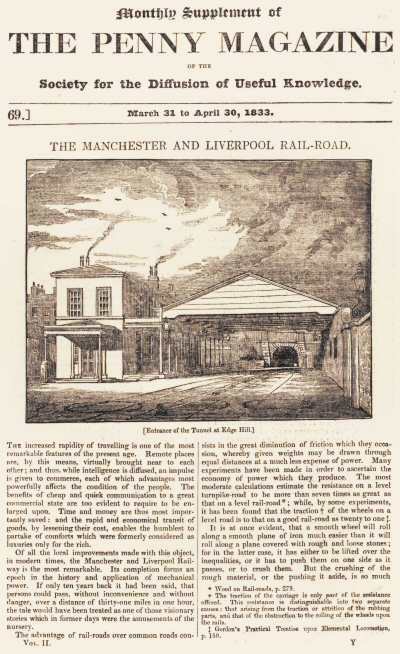
The Manchester and Liverpool Rail-Road
The increased rapidity of traveling is one of the most remarkable features of the present age. Remote places are by this means, virtually brought near to each other; and thus, while intelligence is diffused, an impulse is given to commerce, each of which advantages most powerfully effects the condition of the people. The benefits of cheap and quick communication to a great commercial state are too evident to require to be en-larged upon. Time and money are thus most importantly saved: and the rapid and economical transit of goods, by lessening their cost, enables the humblest to partake of comforts which were formerly considered as luxuries only for the rich.
Of all the local improvements made with this object, modern times, the Manchester and Liverpool Railway is the most remarkable. Its completion forms an epoch in the history and application of mechanical power. If only ten years back it had been Reid, that persons cold pass, without inconveniences and without danger, over a distance of thirty-one miles in one hour, the tale would have been treated as one of those visionary stories which in former days were the amusements of the nursery.
The advantage of rail-roads over common roads consists in the great diminution of friction which they occasion, given weights may be drawn through equal distances at a much less expense of power. Many experiments have been made in order to ascertain the economy of power which they produce. The most moderate calculation estimate the resistance on a level turnpike-road to hem more than seven times as greet a that one level rail-road (1); while, by some experiments, it has been found that the traction (2) of the wheels on a level road is to that one good rail-road as twenty to one.(3) It is at once evident, that a smooth wheel will roll along a smooth plane of iron much easier than it will roll along a plane covered with rough and loose stones; for in the latter case, it has either to he lifted over the inequalities, or it has to push them on one side as it passes, or to crush them. But the crushing of the rough material, or the pushing it aside, is so much waste of power; and hence the great advantages of a smooth road(4).
(1)Wood on Rail-roads. p. 279.
(2)The traction or the carriage is only part of the resistance offered. This resistance is distinguishable into two separate causes: that arising from the traction, or attrition of the rubbing parts, and that of the obstruction to the rolling of the wheels upon the rails
(3) Gordons Practical Treatise upon Elemental Locomotion p. 150.
(4) Mr. Telfords Report on the state of the Holyhead and Liver-pool roads contains the result of some experiments on different roads, by which it is found that
|
|
lbs |
|
On well-made pavement the draught is . . . . |
33 |
|
Ou a broken stone surface, or old flint road . . . |
65 |
|
On a gravel road |
147 |
|
On a broken stone road, upon a rough pavement foundation |
46 |
|
On a broken stone surface, upon a bottoming of concrete formed of Parkers cement and gravel . . . |
46 |
Rail-roads on an extended scale are of very recent application; although for the last two Centuries- they have, with various modifications, been adopted in the collieries of Northumberland, where the expense of conveying so heavy an article as coals by ordinary methods first showed the necessity for discovering some plan by which the labour might be lessened. Up to the year 1600, it appears that coals were conveyed from the collieries in carts on common roads,? and in some cases in baskets on the backs of horses. The precise period when any improved method of conveyance was first at-tempted is not ascertained, but this was certainly between the years 1602 and 1649. Rail-roads were about that time first adopted. They were then made of timber; and, though very rude in their construction, materially diminished the resistance, and therefore economised the power.
These wooden rails consisted of parallel oaken blocks placed tranversely on the road at intervals of from two to three feet, and fastened firmly into the ground; long thick pieces of wood of about six or seven inches in breadth were laid on these, securely fastened to them and joined together at the different lengths by pins, forming two continuous parallel lines on which the wheels of the waggon traversed. These roads were very imperfect and perishable. The timber was soon worn away by the attrition of the wheels, and repairs were constantly required ; the holes made in the transverse blocks or sleepers became too large for the pins attar these had-been once or twice displaced-in order to renew the rails; while the constant treading of the horses feet weakened and ultimately destroyed the blocks in the middle, and they were in consequence soon made in-efficient. To remedy this evil an improvement called the double rail-way was made. This consisted in laying other pieces of wood on the first, to which they were fastened by pins. These upper pieces could therefore be renewed when worn out without injury to the other parts; and as the rails were raised from the ground the sleepers could be covered and secured from the action of the horses feet.. Such roads were still; however, of rude formation, and were liable to be constantly out of repair, notwithstanding which they were long used with little or no alteration at the collieries of Northumberland and Durham. The regular load of a horse with a cart along the common road was 17 cwt: while on this rail-road it was 42 cwt. The advantage so gained appears to have been thought quite .sufficient, and no farther economy of power was for some time sought to be obtained. Where there were any acclivities or abrupt curves, thin pieces of wrought iron were nailed over those parts of the rail to diminish the resistance opposed to the wheels; and so that one horse, could draw 42 cwt., the required maximum of power; no farther effort was considered necessary. Until within a very few years rail-roads have been considered as only supplementary to canals,?to be employed in short distances, or where the nature of the ground has precluded the application of inland navigation. Accordingly, while the attention of some of the most enterprising and highly gifted minds was turned to the consideration of the important point of inland water communication, the better construction of rail-roads was overlooked and neglected. This country is now every where traversed by canals, intersecting each other, which afford inland navigation between all parts of the king dom. This very excellence for a long lime seemed to preclude the necessity of any farther improvements in the facility of communication.
The superiority of rail-ways is however very great, where celerity of motion is required, as this cannot be obtained with the same economy on canals, through the employment of horsepower. When locomotive carriages are substituted on rail-roads, the difference is rendered still more striking. It has been found by ex periment that at the rate of two miles an hour, a horse can drag three times as much weight in a boat on a canal as he can drag upon a carriage on a rail-road. At the rate of three miles and a half an hour, his power exerted on the rail-road, or in tracking on the side of a canal, is exactly the same. But at an increase of speed beyond this rate, the disproportion in favour of rail-roads becomes very great; so that at the rate of six miles an hour, owing to the resistance of the water, he can draw upon the railroad a weight three times heavier than he can draw in a boat on a canal, As the velocity is increased the difference becomes still greater (5).
(5) Wood on Rail-roads, p.305.
It is now between fifty and sixty years since iron has been gradually substituted for wood on railroads and their construction has by degrees become better understood and executed. The date of the first introduction of ? cast and wrought iron rail-ways, is variously stated in different accounts: it is most probable that iron was substituted for wood in several places without any concert, and that the adoption of cast iron was not the result of any one discovery. From 1768 to 1776 is the period when the plate=rail-road (more; generally known: as the tram road) was first used. This, with but slight modifications; is the same as the plate-rail of the present day. It consists of cast-iron rails about four feet long, having a flange or upright ledge three inches high, to keep the wheel upon the horizontal part, which is about four inches-wide and an inch thick, and another flange at the other side projecting downwards to strengthen the, rail. These rails ar e fixed together and fastened securely to stone supports. .At first they were made to rest on the transverse wooden blocks already described, stretched across the Whole breadth of the rail-road, or upon short square wooden sleepers: stone blocks are now mostly used. An improvement of the plate-rail is the edge-rail, which? is now most generally adopted. The advantage of the ledge over the plate-rail is the diminution of friction. In this case the ledge is placed on the wheel instead of the rail, and it is found that a ledge of one inch depth is sufficient to keep it in its situation.
It has been found by experiment that on a well constructed rail-road a horse will draw
|
10 |
tons at the rate of |
2 |
Miles an hour. |
|
6.5 |
|
3 |
|
|
5 |
|
4 |
|
|
4 |
|
5 |
|
|
3.5 |
|
6 |
|
But it must be borne in mind that the great superiority of a rail-way over a common road can only exist on an exact level. Let there be an ascent so small as scarcely to attract observation, and this advantage is at once very materially diminished; while, at greater elevations, it is entirely lost. Since the traction of the wheels is so much less on rail-ways than on common roads, it follows that when the force of gravity is brought into operation by an ascending plane, this opposing force, being proportioned? to the load, will be much greater than on a common road. It has been found by experiment, that if a locomotive engine draws, by the adhesion of its four wheels, 67.25 tons on a level, it will only draw, by the same adhesion, 15.21 up an inclination of one in a hundred; at an inclination of one in fifty, it will .draw scarcely any load; and at an inclination of one in twelve, a locomotive engine will not ascend by itself on a rail-way, the force exerted causing the wheels to turn round on the same spot instead of advancing. Abrupt curves and sudden turnings increase resistance very much. The medium friction of a train of five waggons on a level rail-way was found by experiment to be nine pounds per ton; while on a curved part, with a radius of about eight hundred feet, it was eighteen pounds per ton (6).
(6) Milnes Practical View of the Steam-engine (Appendix). From the same authority it appears that the draught on a rail-road was one hundred and eight pounds per ton, at the rate of three miles an hour when the rails were dry, and only sixty-eight pounds when the rails were wet. ! Dupia, Vol. i, p. 207.1
In the formation of rail-ways for the general purposes of traffic, it is therefore essential to their beneficial effect that they should be made as nearly as possible on a level straight line. Most of the rail-ways heretofore constructed have been for the conveyance of the products of the mines, such as of coals from the pits to the river side; and since the weights were all to be carried in one direction, the road had an inclination downwards given to it, requiring no power but that of gravity to produce loco-motion. Where the traffic is to and fro, this arrangement must of course be abandoned.
Since the close of the last century rail-ways have multiplied extremely in the neighbourhood of our collieries and other mining districts. In Glamorganshire alone it is estimated that there are three hundred miles of rail-ways. These are, however, all detached, isolated, and private undertakings, appropriated solely to the conveyance of mineral produce to those points where water communication is established.
The Stockton and Darlington, Rail-way was the first laid down, by Act of Parliament, for the conveyance of general merchandize and passengers, as well as of coals. This road was opened in the autumn of 1825. It is about twenty five miles in length; and consists of only a single rail-way, having at intervals of every quarter of a mile "sidings" to allow of the carriages passing each other.
The project of a rail-way between Liverpool and Manchester was first entertained in 1822. Before so great and novel an undertaking could be carried into execution, many preliminary measures were necessary, and much opposition was to be expected from those whose interest might possibly be affected by the successful issue of the project. A company was formed under the title of "The Liverpool and Manchester Rail-road Company." and their prospectus was issued in October, 1824. £400,000 was to be raised by shares of £100 each. It was found, subsequently, that this sum was inadequate to the purpose. A bill was brought into Parliament for the formation of the rail-way in 1825. The opposition made to the measure was so strenuous, however, that it was not till the ensuing session that the company succeeded in its application.
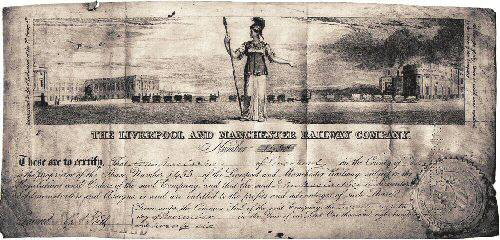
The peculiar connection between Liverpool and Manchester renders a rapid and cheap communication between these places a subject of national interest and importance. Liverpool is the port whence Manchester receives all her raw material, and to which she returns a large portion of her manufactured goods for shipment to all parts of the world. This constant and increasing interchange of merchandize, and, in consequence, the incessant intercourse of the inhabitants of the two towns, must in an eminent degree be promoted and facilitated by a quickness of transit hitherto supposed impossible. It is true, there is water communication between Liver-pool and Manchester by two separate routes; namely, on the river Mersey, from Liverpool to Runcorn, a distance of sixteen or eighteen miles; and thence, either by the Duke of Bridgewaters canal, or by a navigation consisting alternately of canals and the rivers Mersey and Trivell. The whole distance by water is about fifty miles. The average length of passage by these conveyances is about thirty-six hours, varying according to the state of the wind and the tide. By the rail-road the transit of goods is affected in about two hours. The economy of time in transport is of the greatest importance in all large commercial operations; and certainty of delivery is an equally important element in the saving of capital. The cotton spinner is no longer required to keep large stocks of the raw material inn his warehouse at Manchester. He buys at the hour when he finds it most advantageous to buy, assured that the delivery of the goods will immediately follow the completion of the contract. Manchester may now be considered as the great cotton factory of most parts of the globe ; and the constantly increasing traffic between this place and Liverpool, could not be carried on by the canal establishments with sufficient dispatch, regularity, and punctuality, at all periods and seasons. The different position of these towns in 1760, when first the Duke of Bridgewaters canal was projected, and in 1824, when the rail-road company was formed, shows the rapid increase of their commercial importance. In 1760 the population of Manchester was about 22,000; in 1824 it was 150,000. In 1790 the first steam-engine was used in Manchester; in 1824 more than two hundred steam-engines were at work, and nearly 30,000 power-looms. In 1760 the population of Liverpool was about 26,000; in 1824 the population was 125,000. In 1760 the number of vessels which paid dock-dues was 2,560; in 1824 this number amounted to 10,000. In 1784 eight bags of cotton were seized by the custom=house officers out of an American vessel arriving at Liver-pool, under the conviction that they could not be the growth of America. In 1824 there were imported into Liverpool from America 409,670 bags of cotton (7). The quantity of goods daily passing between Manchester and Liverpool was estimated in 1824 at 1,000 tons, but since that period it has much increased.
(7) These statistical facts are taken from Booths Account of the Manchester and Liverpool Railway, p. 3.
The legislature having concurred in the practicability and advantages of the .rail-way, the undertaking was commenced in June, 1826, under the direction of Mr. George Stephenson. It was proposed to lay the rail-way as nearly as possible in a straight line between the two places. The nature of the country rendered this undertaking a task of no ordinary difficulty. Tunnels were to be made; eminences to be excavated, artificial mounds to be erected; and a moss (Chat Moss), four miles in extent, was to be drained and leveled in the centre and embanked at each end. This latter was a most arduous task, and the practicability of carrying it into execution was seriously questioned in the (louse of Commons; by some of the witnesses who were examined it was deemed impossible, and one asserted that it could not be accomplished at the cost of £200,000 (8). Chat Moss is a "huge bog" of so soft and spongy a texture, that cattle cannot walk over it. The bottom is cornposed of day and sand, and above this, varying in depth from ten to thirty-five feet deep, is a mass of vegetable pulpy matter. This barren waste comprises an area of about twelve square miles; and, according to moderate calculation, contains at Ieast sixty millions of tons of vegetable matter.
(8) In the general abstract of expenditure, the Chat Moss account is put down at £427,719, lls, l0d.
The first actual operations of the company were directed to the draining of this moss. Many difficulties occurred in the progress of the work, but they were all at length overcome. On the eastern border an embankment of about twenty feet had to be raised above the natural level. The weight of this embankment pressed down the surface of the moss, and many thousand cubic yards gradually disappeared. Perseverance, however, at length succeeded in consolidating the moss, and giving to it sari equable pressure. On the western side an embankment is formed of moss, nearly a mile in length, and from ten to twenty feet perpendicular height, at an inclination of rather less than forty-live degrees, which was found from experience to stand better than if at a greater angle. Sand and gravel, from two to three feet in depth, were laid over this; and on the whole so prepared, the permanent road, consisting of a layer of broken stone and sand, was deposited.
At one part, about three-quarters of a mile from the western edge, distinguished as the " Flow Moss," the semi-fluid consistency of the moss required some farther contrivances to render it sufficiently firm: Hurdles were placed upon it, thickly interwoven with twisted heath, forming a platform on which sand and gravel are laid, and on which the wood sleepers which support the rails are placed. The quantity of moss required for the embankments, and which was dug from the neighboring parts, amounted to five hundred and twenty thousand cubic yards.(9)
(9) Companion to the Almanac for 1829; p. 228.
The rail-way enters Liverpool by means of a tunnel and inclined plane, thus effecting a communication with the docks without interfering with a single street, a passage being formed in fact underneath the town. The first shaft of this tunnel was opened in September, 1826. Very little progress was made in this work for the first few months from its commencement, but during the whole of the ensuing year the operations were carried on with great perseverance and activity. This tunnel is twenty-two feet wide and sixteen feet high ; the sides are perpendicular for five feet in height, surmounted by a semi-circular arch of twenty two feet diameter; the total length is two thousand two hundred and fifty yards. The entrance in the Companys yard in Wapping is by an open cutting twenty-two feet deep and forty-six wide, affording spaces for four lines of rail-way. Between the lines are pillars. For the length of two hundred and eighty yards the rail-way is perfectly level, curving to the south-east. Over this part are the Companys warehouses, to which there are hatchways or trap-doors, allowing the waggons placed underneath to he readily. loaded or unloaded. The inclined plane, which is a perfectly straight line, commences here: it is one thousand nine hundred and seventy yards in length, with a uniform rise of 1 in 48, the whole rise from Wapping to the tunnel-mouth at Edge-hill being one hundred and twenty-three feet. A considerable portion of this excavation was hewn through a solid rock, consisting of a fine red sand-stone, which forms in these parts a natural roof, requiring neither props nor artificial arching. But in some places the substance excavated was with difficulty supported till the masonry which formed the roof was erected.
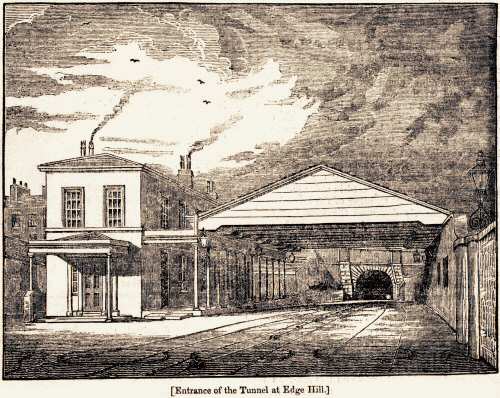
The construction of this tunnel was commenced in seven or eight separate lengths; upright shafts being opened in each of these places, communicating with the surface, and through which the substance excavated was conveyed away. The accuracy of the work rendered the joining exact and perfect in every case. In the early part of September, 1828, the whole was completed at a cost of £34,791. The depth of the super-stratum of earth, from the roof of the tunnel to the open surface of the ground varies from five to seventy feet. The whole length of the tunnel is furnished with gas-lights, suspended front the centre of the arched roof, at distances of twenty-five yards apart; and the sides and roofs are white-washed, for the better reflection of the light. At the upper end of the inclined plane the tunnel terminates in a spacious area, forty feet below the surface of the ground, cut out of the solid rock, and surmounted on every side by walls and battlements. From this area there returns another small tunnel, quite distinct from the larger one, and communicating with the upper part of Liverpool. Its dimensions are two hundred and ninety yards in length, fifteen feet wide, and twelve feet high. It terminates in the Companys premises in Crown Street, which is the principal station for the rail-way coaches. Above this area on the surface of the ground two steam chimneys are erected of one hundred feet in height; these are built in the forma of columns, with handsome capitals. In the area below are two stationary engines, by which the loaded waggons are drawn up the inclined plane. Proceeding eastward from the two tunnels, the road passes through a Moorish arch-way, erected from a design of Mr. Foster. This connects the two engine-houses, and forms the grand entrance to the Liverpool stations.
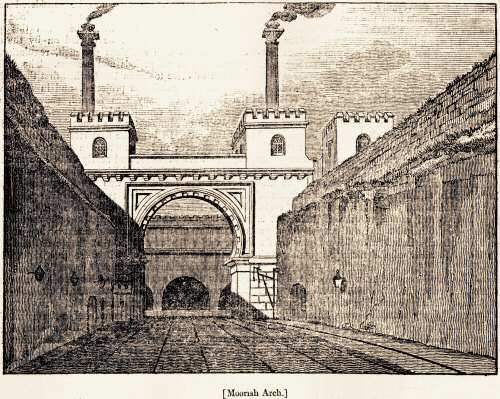
The road in. this part curves slightly, but is perfectly level for one thousand yards ; it then for the length of five miles and a half has a fall of only 1 in. 1092, or of four feet in a mile,?a declivity so slight and uniform as not to be perceptible. This nearly level line was not obtained without much labour. A little beyond the perfect level the road has been formed in a deep excavation made through marl. Beyond this, about half a mile to the north of the village of Wavertree, is a pas-sage cut through a steep eminence, called Olive Mount, the substance of which is entirely rocky. This deep and narrow ravine, formed in the solid rock, is more than two miles in extent, and in the deepest_ part is seventy feet below the surface of the ground; the road here is little more than sufficiently wide for two trains of carriages to pass each other. It winds gently round to the south-east, and the view is bounded by the perpendicular rock on either side. Four hundred and eighty thousand cubic yards of stone have been dug out of this excavation, and have been made available to the building of bridges and walls on this portion of the line. Over the marl and the Olive Mount excavations are several bridges to form the requisite communications between the roads and farms on the opposite sides of the rail-way.
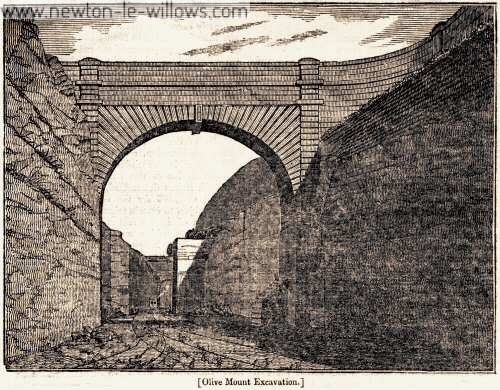
Emerging from the Olive Mount cutting, the road is thence artificially raised by the great Roby embankment, which is nearly three miles long, varying in height from fifteen to forty-five feet, and in breadth at the base from sixty to one hundred and thirty-five feet. This is formed of the materials dug out from the various excavations. The quantity employed was 550,000 cubic yards. After passing the Roby embankment the rail-way crosses, by means of abridge, over the Huyton turnpike-road; and proceeds in a slightly curved direction to Whiston, between seven and eight miles from the station at Liverpool. Here the rail-road continues for a mile and a half in a straight line, having in this length an inclination of 1 in 96; at the top of this inclined plane the road runs nearly two miles on an exact level, produced by the excavation of 220,000 cubic yards. Over this part, called Rainhill level, the turnpike road between Liverpool and Manchester proceeds, crossing the line of rail-way at an acute angle of 34 degrees, by means of a substantial stone bridge. At the other side of this, two miles of level is the Sutton inclined inane, which is similar in extent and inclination to the Whiston plane, descending from Rainhill in the opposite direction. A little distance thence is Parr Moss; over which the road is carried. This Moss is twenty feet deep, and extends three-quarters of a mile in the line. The materials for the road which forms the rail-way on this unsubstantial matter was obtained from the excavations of the Sutton inclined plane, which produced 144,000 cubic yards of clay and stone. The heavy deposit sank to the bottom, and now forms with the moss a firm embankment, in reality twenty-five feet high, though only four or five feet above the surface of the other parts of the moss. Not very far from this, and about half way between Liverpool and Manchester, is the valley of the Sankey, at the bottom of which the canal flows. Over this valley, without interruption to its navigation, the rail-way is carried along a magnificent viaduct, supported on nine arches; each arch is fifty feet span, and varies from sixty to seventy feet in height; these are built principally of brick with stone facings; the width of the rail-way between the parapets is twenty-five feet. The piling for the foundation of the piers of this great viaduct was a business of much labour and cost, but indispensable for the security of the super-structure. About two hundred piles, varying from twenty to thirty feet in length, were driven hard into the foundation site of each of the ten piers.
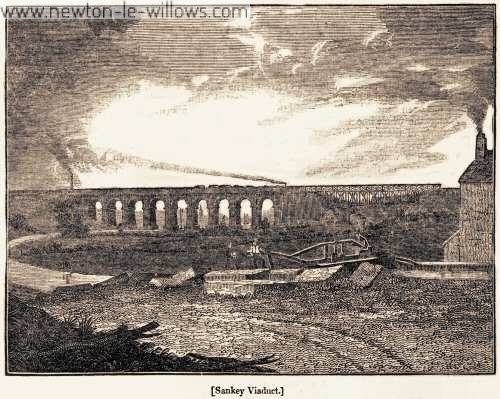
The approach to this structure is by an embankment attaining to the height of sixty feet. This is formed principally of clay dug out from the high lands on the borders of the valley. Not far from Sankey is Newton, near to which town the rail-way crosses a narrow valley by a short but lofty embankment, and by a handsome bridge of four arches, each having forty feet span. The turnpike-road from Newton to Warrington passes under one of these arches, and beneath another flows a small river. At Kenyon, a few miles beyond Newton, is an excavation of greater magnitude than any other on the line, 800,000 cubic yards of clay and sand having been dug out of it. Near the end of this cutting the Kenyon and Leigh Junction Rail-way joins the Liverpool and Manchester line by two branches, pointing to the two towns respectively. This rail-way joins the Bolton and Leigh line, and thus forms the connecting link between Bolton, Liverpool, and Manchester. After the Kenyon excavation is the Brosely embankment, and a little beyond that commences the Chat Moss. The difficulties overcome here have already been briefly described; and now, by the ingenuity and perseverance of man, trains of carriages of many tons weight are constantly passing and re-passing over a bog, which originally would not allow of a person walking over it except in the driest weather. About a mile from the extremity of the moss the rail-way crosses the Duke of Bridgewaters canal, by a neat stone bridge of two arches. Some little distance beyond is the village of Eccles, four miles from Manchester. Through this extent is an excavation from which 295,000 cubic yards of earth have been dug out. At Manchester the rail-way crosses the river Irwell by a very handsome stone bridge, of two arches of sixty-five feet span, thirty feet from the water; and then over a series of twenty-two arches, and a bridge, to the Companys station in Water-street. The whole line of road is a distance of thirty-one miles.
It was a matter of some importance to determine whether cast or wrought iron rails should be used for this undertaking; each description had its advocates; but after deliberation and inquiry, those of wrought iron obtained the preference. These were made in lengths of five yards each, weighing thirty-five pounds per yard. The blocks, or sleepers, are some of stone and some of wood. Those of stone contain nearly four cubic feet each: they are laid along about eighteen miles. The wood sleepers are made of oak or larch; and are principally laid across the embankments, and across the two districts of moss, wherever it is expected that the road may subside a little. The stone blocks are let firmly into the permanent road, which consists of a layer of broken rock and sand about two feet thick, one loot of which is placed below the blocks, and one foot distributed between them, serving to keep them in their places. They are placed at intervals of three feet; in each block two holes six inches sleep and an inch in diameter are drilled, and into these are driven oak plugs. The rails are supported at every three feet on cast-iron chairs or pedestals, into which they are immediately fitted and securely fastened; the chairs are placed on the blocks, and firmly spiked down to the plugs, the whole forming a work of great solidity and strength; the rails are about two inches in breadth, and rise about an inch above the surface; they are laid down with extreme correctness, and consist of four parallel rails . four feet eight inches apart, allowing two trains of carriages to pass in opposite directions with perfect safety. Under the warehouses at Liverpool there are four distinct rail-ways for the greater convenience and facility of loading and unloading the waggons.
It may be observed, from the description given of this rail-road, how much the principle was acted upon of making it as far as practicable perfectly level and straight. With the exception of the two inclined planes at Rainhill, where the inclination is 1 in 96, there is no greater inclination than in the ratio of about 1 in 880. The surface of the rails at the top of the tunnel in Liverpool is forty-six feet above the rail-way at Manchester. Along the whole extent there are no abrupt curves; .the curvature rarely exceeds a deviation from a straight line of more than four inches in twenty-two yards.
At the first projection of the rail-road .it was by no means decided what kind of power should be employed for locomotion, whether horses or locomotive engines, or fixed engines drawing the load by means of ropes from one station to another. Each of these methods had been tried. The directors were not, however, at a loss to decide from the paucity of evidence brought before them; and the schemes offered by some projectors were of the most various and extravagant nature, Mature consideration, and the experience obtained in other undertakings, satisfied the directors that the employment of horses was entirely out of the question. At length it was determined, in April, 1829, to offer a premium of £500 for the most improved locomotive engine, subject to certain stipulations and conditions.
The trial of the different engines offered, in competition for the reward just mentioned, took place on the 6th of October, 1829, before competent judges, on the level portion of the rail-way at Rainhill. Four steam-carriages were entered on the lists to contend for the premium. The distance appointed to be run was seventy miles, and the engine, when fairly started, was to travel on the road at a, speed of not less than ten miles an hour, drawing after it a gross weight of three tons for every ton of its own weight. This distance was to be accomplished by moving backwards and forwards on a level plane of one mile and three-quarters in length, by which arrangement the machine had to pass over the plane forty times, and make as many stoppages. The "Rocket" weighing four tons five hundred weight, per-formed the distance in less than six hours and a half, including stoppages. The speed at which it traveled was frequently eighteen miles per hour, and occasionally upwards of twenty. In this trial, half a ton of coke was consumed as fuel; coke being used instead of coal to prevent the annoyance of smoke. This engine was the only one which performed the stipulated task. The premium was awarded by the directors to Mr. Booth and the Messrs. Stephenson. Engines similar to the "Rocket" are those now used on the Manchester and Liverpool rail-way. The peculiarities of this engine could not be rendered intelligible without some previous knowledge of the construction of an ordinary steam-engine. The following cut exhibits its external appearance.
We have now traced the steps of this important national work to the time when the engines were prepared, and in a fit state for being applied to useful purposes. The stupendous undertaking was finished in September, 1830, little more than three years having been consumed in the completion of a work in which difficulties- of no ordinary kind presented themselves. A brief recapitulation of what was accomplished in the space of thirty-one miles will evince the skill, energy, and perseverance which were brought to the task. Two tunnels were excavated, six considerable eminences cut through, great part of which excavations were hewn out of the solid rock; upwards of three millions of cubic yards of stone, clay and soil, have been dug out of the different excavations. From these materials artificial mounds of great height and extent have been raised through valleys, and semi-fluid matter has been consolidated into strength and consistency. Along the whole line there are sixty-three bridges;. under thirty of these the rail-way passes, on twenty-eight it passes over the common road, and on five it is conducted over the waters of the river Irwell, of canals, &c. Twenty-two of the bridges are composed of brick, seventeen of wood and brick, eleven of brick , and stone, eleven of wood, and two of stone and wood. The weight of the double lines of rail laid down is 3847 tons, and of the cast iron pedestals on which they are fastened, 1428 tons. There are occasional lines of communication between the rail-ways, and additional side lines at the different depots.
The total sum expended in effecting this magnificent project, and putting the whole in a situation for active operation, including the cost of constructing warehouses machinery, and carriages, is estimated at £820,000.
On the 15th of September, 1830, the rail-way was opened by the passage of eight locomotive engines, all built by Messrs. Stephenson and Co. To these were attached twenty-eight carriages of different forms and capacities, capable of containing altogether a company of six hundred persons. Preparations were made on a scale of great magnificence to render this a ceremony of no ordinary kind; and some of the most distinguished characters were invited and attended, to go first over that ground which is now become the scene of daily traffic. The Northumbrian, a steam-engine of fourteen-horse power, took the lead, having in its train three carriages. The performance of the engines was extremely satisfactory until they reached Parkfield, seven-teen miles from Liverpool, when they were stopped to renew the feeders and to take in a fresh supply of fuel. Here several of the company alighted from the different carriages; on again starting, that fatal accident happened to Mr. Huskisson, which, after a few hours of extreme agony, terminated his life.

On the following day the Northumbrian left Liverpool with one hundred and thirty passengers, and arrived at Manchester in one hour and fifty minutes. In the evening it returned with twenty-one passengers and three tons of luggage in one hour and forty-eight minutes; and on Friday, the 17th, six carriages commenced running regularly between the two towns, accomplishing the journey usually in much less than two hours. On the 23d of November, 1S30, one of the engines went over the distance in the space of one hour, two minutes of which time was taken up in oiling and examining the machinery about midway. No carriages were attached to the engine, and it had only the additional weight of three persons. On the 4th of December following the "Planet" locomotive engine took the first load of merchandise which passed along the rail-way between Liver-pool and Manchester. Attached to the engine were eighteen waggons, containing two hundred barrels of flour, thirty-four sacks of malt, sixty-three bags of oat-meal, and a hundred and thirty-five bags and bales of cotton. The gross weight drawn, including the waggons and engine-tender, was about eighty tons. The speed over level ground was at the rate of twelve to fourteen miles per hour. The train was assisted up the Whiston inclined plane by another engine, at the rate of nine miles an hour; it descended the Sutton inclined plane at the rate of sixteen miles and a half an hour; and the average rate of the remaining part was twelve miles and a half an hour. The whole journey was performed in two hours and fifty-four minutes, including three stoppages, of five minutes each, for oiling, watering, and taking in fuel. This was the greatest performance heretofore accomplished by any locomotive power, but it was only the commencement of much greater speed. The Samson engine, on the 25th of February, 1831, started with a train of thirty waggons from Liver-pool, the gross weight of the whole being 1641 tons, and with this enormous weight it averaged a speed of twenty miles an hour on level ground. It was assisted up the inclined plane by three other engines, and arrived in Manchester within two hours and thirty-four minutes from first starting; deducting thirteen minutes for stoppages employed in taking in water, &c., the net time of traveling was two hours and twenty-one minutes. The quantity of coke consumed by the engine in this journey was 1376 lbs. being not quite one-third of a pound per ton per mile. By taking the average speed throughout at thirteen miles an hour, the same work would have required seventy good horses.
From the first opening of the rail-way in September to the end of that year, more than 70,000 persons passed by it for various distances between Liverpool and Manchester, without personal injury to a single individual, except one person, who while mounting on the, roof of one of the carriages had his leg severely bruised by coming in contact with another vehicle. The security, and celerity of this mode of conveyance being thus clearly established, it has become the chief mode of personal communication between the two towns, in the second half year of 1832, however, the conveyance of passengers appears to have materially decreased. This, the directors in the last Report attribute to temporary causes. This Report contains some further interesting details, of which the following is the substance
The company carried in the last half year of 1832, 86,842 tons of goods, and 39,940 tons of coal, showing an increase of 7,821 tons of goods, and 10,484 tons of coal, beyond the previous half year. The total number of passengers was 182,823, or 73,498 fewer than were carried in the first six months of 1832.
|
|
£. |
s. d. |
|
The total receipts for the half year were |
80,902 |
2 10 |
|
Total disbursements
|
48,218 |
8 10 |
|
Leaving a net profit of for the half year ending Dec. 31, 1832. |
32,623 |
14 0 |
The rate of profit on the transport of each ton of goods and coals appears to have materially increased during the same half year.
A very general opinion has been gaining ground, that the great expense attending the wear and tear of the locomotive engines would render the adoption of some other plan necessary. On this subject the directors admit that in this branch of their expenditure they have met with unexpected discouragement, and with difficulties which they have not yet been able to overcome. The principal items of excessive expenditure in this department have arisen from the frequent renewal of the tubes and fire-places, which, in most of the engines, have been found to burn very rapidly away. To this general result, however, there have been some exceptions; for the company have engines which have run between twenty and thirty thousand miles, with very inconsiderable repairs either to the fire-places or the tubes.
According to the Report, the total amount of capital stock created from the commencement to the 31st December last, whether in shares or by loan, is £1,024,375, every farthing of which has been expended on the works.
The proprietors have divided out of the net profits of the concern up to the 30 th June, 1832 £112,040 12s 6d
And the directors are about to recommend a further dividend for the half year ending 31st December last, of £ 33,468 15s 0d
Making a total of realized profits out of the working of the concern, and altogether independent of the capital invested, of £145,509 7s 6d
Being for a period of about two years and a quarter.
A trip, as it is called, by this extraordinary road for the first time is an event which cannot readily be effaced by the recollections of more common modes of travelling. A pleasurable wonder takes possession of the mind, as we glide along at a speed equal to the gallop of the race-horse. It might be supposed that so great a speed would almost deprive the traveller of breath, and that he could not fail to be unpleasantly conscious of the velocity with which he cut through the air. The reverse is, however, the case; the motion is so uniform, and so entirely free from the shaking occasioned by the inequality or friction of common roads, that the passenger can scarcely credit he is really passing over the ground at such a rapid pace, and it is only when meeting another train, and passing it with instantaneous flight, that he is fully aware of the velocity of his career. The novelty of the scene is delightful: now, where the natural surface of the ground is at the highest, we travel embosomed in deep recesses, and then, where the ordinary course of the road would lead through a valley, we "ride above the tops of the trees," and look down upon the surrounding country. The reflecting traveller probably falls into a pleasing vision arising out of the triumph of human art. He sees the period fast approaching when the remotest parts of his own country shall be brought into easy and rapid communication; and he looks beyond this probable event of a few years, to the more distant day when other nations shall emulate these gigantic works of peace. He sees the evils arising out of the differences of language, and soil, and climate, all vanishing before the desire of mankind for peaceful commercial intercourse; and as he knows that the prejudices and mistaken interests which separate one district of the same nation from another are broken down by such noble inventions as these, he feels that the same spirit of civilization which results from that exercise of our reason, which is be-stowed by a beneficent Providence, will eventually render all men as brethren, and children of one great Father.
Transcribed from “The Penny Magazine, March 31 to April 30, 1833”
As usual with my transcriptions please be aware, I can neither type or spell very well, so errors and omissions in the history may well exist.
Transcription, Images, formatting and Errors. © Steven Dowd 2004.

